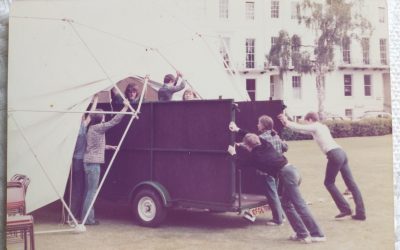I’ve been rehearsing Judith Weir’s ‘Airs from Another Planet’, a superb sextet for piano and wind instruments (in this case, the wind players of the chamber group Daniel’s Beard). It’s for the opening concert of the Cottier Chamber Project in Glasgow on 5 June.
Judith’s piece has the delightful (and typically witty) subtitle, ‘Traditional music from outer space’. We have had fun trying to determine which traditional music is the inspiration for her other-worldly deconstructions. What an imagination!
Someone asked me how long it had taken me to learn the piano part. I truthfully said it had taken many weeks. The piano part is rhythmically very intricate, and its complex flickering harmonies are unguessable. As soon as I started practising it, I realised it was going to take a long time. Even after a good session, the music would slip back the next day to a condition of unfamiliarity. My ear wouldn’t confirm whether or not I’d played exactly those chords before. Slowly I cemented my acquaintance with the score until it felt natural. Don’t get me wrong: I regard this as time well spent for such an intriguing piece.
Nevertheless I couldn’t help sighing wistfully when I heard Bob reminiscing about when Bernstein’s ‘West Side Story’ became all the rage in London, after the film hit UK cinemas. Bob and his fellow students rushed out to buy the score. Night after night they gathered round a piano in their student residence, gleefully playing and singing the work over and over again for sheer pleasure. This was only possible, of course, because they could sight-read the score.
West Side Story is a ‘musical’, not an abstract classical piece, but it was also a new work by a serious composer. We couldn’t recall any occasion when our musician friends had rushed out to buy the score of a contemporary classical piece, let alone fought to be the one who got to play the piano at the next merry read-through.
This must be a lot to do with the fact that contemporary notation is often fiendishly complicated. As there is currently no musical ‘lingua franca’, it seems as if every composer has his or her own language, which performers have to learn from scratch. Although the music may be striking from the outset, it’s not generally sight-readable; even when the language has been deciphered, it often takes ages to settle in the memory. Nobody minds putting in the work if the result is compelling, but it isn’t always.
So it’s hard to imagine a new work detonating joyfully on a bunch of musicians as ‘West Side Story’ did on Bob and his friends. And this must be at least partly because most contemporary works are not sight-readable. It’s a sad situation really. Why is the music of our own time so challenging, even for professional musicians?




I enjoyed your blog entry, Susan. Points well made. But I find lots and lots of music in a way difficult to sight read. Bach, Beethoven, Brahms, Chopin, Scryabin, and so forth. Though of course I do sight read all these composers’ music, accepting that what I do is an approximation of the detailed and intricate notation. The language is familiar which means I am confident to sight read approximately, knowing that metre, style, melody, etc. follow patterns that I have learned from experience.
Similarly when learning recent music, some pieces are much more easy to sight read than others. Often new music can be eminently sight readable. But often it’s not. Though again I give it a shot, knowing that what I do is an approximation. I might try and get something of the mood and gesture, if not the right rhythm or pitches. But through familiarity with new music over the years it becomes much easier. Sight reading new music is something that can be practised just as sight reading Busoni can be. If our conservatoires and universities bravely taught new music as standard, rather than as an occasional novelty item, I think musicians would be much more prepared and well versed in the variety of techniques and gestures that feature surprisingly often in new works.
Would love to hear Weir’s sextet. A wonderful composer!
Thank you for these insightful comments, Philip. You’re right of course that much ‘old’ music is hard to sightread and that the sightreading of new music can be practised. However, the deeper question remains of why new music is not taught as standard repertoire in music colleges. It contrasts sadly with the days when Brahms published a new symphony and the music students and indeed amateur musicians of the day would rush out to buy a piano duet version of the score, which publishers would have had prepared in the knowledge that music-lovers would want such a thing immediately. The new music of our day is not so close to many people. It’s interesting to ponder why not.
Yes completely agree. And education is the key, as you say. My suspicion is that instrumental tutors by and large teach what they were taught, and the cycle of familiar repertoire continues from one generation to the next.
I feel the question about whether a piece can be sight-read or not is actually of lesser importance to a bigger one: why don’t listeners rush out and buy contemporary classical music? It happens in the other arts – people buy novels, buy film tickets, go to galleries. It doesn’t happen in contemporary classical music. My own view is that this is the legacy of something fundamental to the relationship between audience and composers breaking in the mid-C20th. There has always been a belief that the audience would catch up with and fall in love with extreme innovation. It didn’t take that long for people to enjoy The Rite of Spring as a concert piece, so the argument goes, therefore everything else will follow. It hasn’t happened, and I will venture, it never will except for a vanishingly small number of people. This is partly because of how distant much of this music is from even an expanded harmony, but also because people are surrounded by popular music which has the effect of reinforcing certain conservative reactions and expectations to do with simple tonal music. I am frequently astonished by the inability of otherwise educated adults even to respond to the music of composers such as Stravinsky, Sibelius, Bax, the more dissonant Vaughan Williams (!). Most listeners have not even adjusted to the harmonic innovations of the mid-C20th. Also, many (including myself) will resist being persuaded that music which elevates pure sound over some form of tonal musical grammar is not a lesser experience.
What a great comment! Thank you, Rikky. I completely agree with you.
Thanks Susan, I’m pleased you liked it. As a composer, music teacher, guitar player and writer of books on popular songwriting, I’ve been mulling over these issues for a long time. In your blog you mentioned problems remembering certain passages in the music: “Even after a good session, the music would slip back the next day to a condition of unfamiliarity. My ear wouldn’t confirm whether or not I’d played exactly those chords before.” If that is happening to you – an accomplished musician with a wide grasp of repertoire – that’s saying something about the music. Further to my comments about the difference between music and varieties of sound art, it is like a conference on James Joyce’s Ulysses hosted and attended by printers and people with a passion for fonts. All day papers are read extolling the beauty of various letters, fonts and font sizes – but the notion that Ulysses might have a grammar and convey meanings is not considered. And one further qualification – I didn’t mean to imply that popular music is inferior – obviously the best of it is as wonderful music as anything else. However, its current dominance is very unhealthy for music more broadly. This is reflected in education also. It is being pumped into our public spaces – shops, banks and cafes, increasingly loud – but string quartets are not. Good luck with all your music making and advocacy.
I’m very much in agreement with you, Rikky, and admire your way of putting it.
As a non-musician I would add that modern composers of so-called classical music began composing for purely specialist audiences–rather than the general music-loving public–somewhere in the first half of the last century. If you, Susan, can’t recall a piece of music a day after having performed it, taking into account all of the preparation prerequisite to your effort, I’m sure you can imagine how unmoved and unimpressed members of a lay audience are likely to be. I’m not proud of it but I am among the legions whose eyes simply glaze over at the mention of just about everything composed after, say, 1950 (perhaps even earlier). It is of course fine for people to want to write, and listen to, such music but surely no one can claim surprise over the fact that its audience will remain tiny.
Well put, Steve, and of course many will agree with you. I also think that the split between ‘serious’ and ‘fun’ music in the early 20th century was a disaster for all of us. Have you come across Alex Ross’s very interesting theories (expressed in his book ‘The Rest is Noise’) about why ‘dissonant modern music’ came to be championed by the powers that be? He explains it much better than I could.